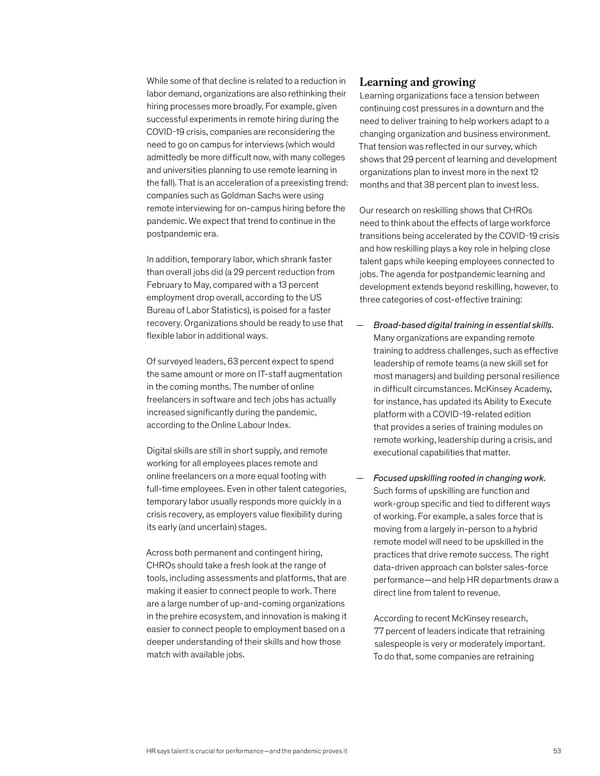While some of that decline is related to a reduction in Learning and growing labor demand, organizations are also rethinking their Learning organizations face a tension between hiring processes more broadly. For example, given continuing cost pressures in a downturn and the successful experiments in remote hiring during the need to deliver training to help workers adapt to a COVID-19 crisis, companies are reconsidering the changing organization and business environment. need to go on campus for interviews (which would That tension was reflected in our survey, which admittedly be more difficult now, with many colleges shows that 29 percent of learning and development and universities planning to use remote learning in organizations plan to invest more in the next 12 the fall). That is an acceleration of a preexisting trend: months and that 38 percent plan to invest less. companies such as Goldman Sachs were using remote interviewing for on-campus hiring before the Our research on reskilling shows that CHROs pandemic. We expect that trend to continue in the need to think about the effects of large workforce postpandemic era. transitions being accelerated by the COVID-19 crisis and how reskilling plays a key role in helping close In addition, temporary labor, which shrank faster talent gaps while keeping employees connected to than overall jobs did (a 29 percent reduction from jobs. The agenda for postpandemic learning and February to May, compared with a 13 percent development extends beyond reskilling, however, to employment drop overall, according to the US three categories of cost-effective training: Bureau of Labor Statistics), is poised for a faster recovery. Organizations should be ready to use that — Broad-based digital training in essential skills. flexible labor in additional ways. Many organizations are expanding remote training to address challenges, such as effective Of surveyed leaders, 63 percent expect to spend leadership of remote teams (a new skill set for the same amount or more on IT-staff augmentation most managers) and building personal resilience in the coming months. The number of online in difficult circumstances. McKinsey Academy, freelancers in software and tech jobs has actually for instance, has updated its Ability to Execute increased significantly during the pandemic, platform with a COVID-19-related edition according to the Online Labour Index. that provides a series of training modules on remote working, leadership during a crisis, and Digital skills are still in short supply, and remote executional capabilities that matter. working for all employees places remote and online freelancers on a more equal footing with — Focused upskilling rooted in changing work. full-time employees. Even in other talent categories, Such forms of upskilling are function and temporary labor usually responds more quickly in a work-group specific and tied to different ways crisis recovery, as employers value flexibility during of working. For example, a sales force that is its early (and uncertain) stages. moving from a largely in-person to a hybrid remote model will need to be upskilled in the Across both permanent and contingent hiring, practices that drive remote success. The right CHROs should take a fresh look at the range of data-driven approach can bolster sales-force tools, including assessments and platforms, that are performance—and help HR departments draw a making it easier to connect people to work. There direct line from talent to revenue. are a large number of up-and-coming organizations in the prehire ecosystem, and innovation is making it According to recent McKinsey research, easier to connect people to employment based on a 77 percent of leaders indicate that retraining deeper understanding of their skills and how those salespeople is very or moderately important. match with available jobs. To do that, some companies are retraining HR says talent is crucial for performance—and the pandemic proves it 53
 What Now? Page 54 Page 56
What Now? Page 54 Page 56